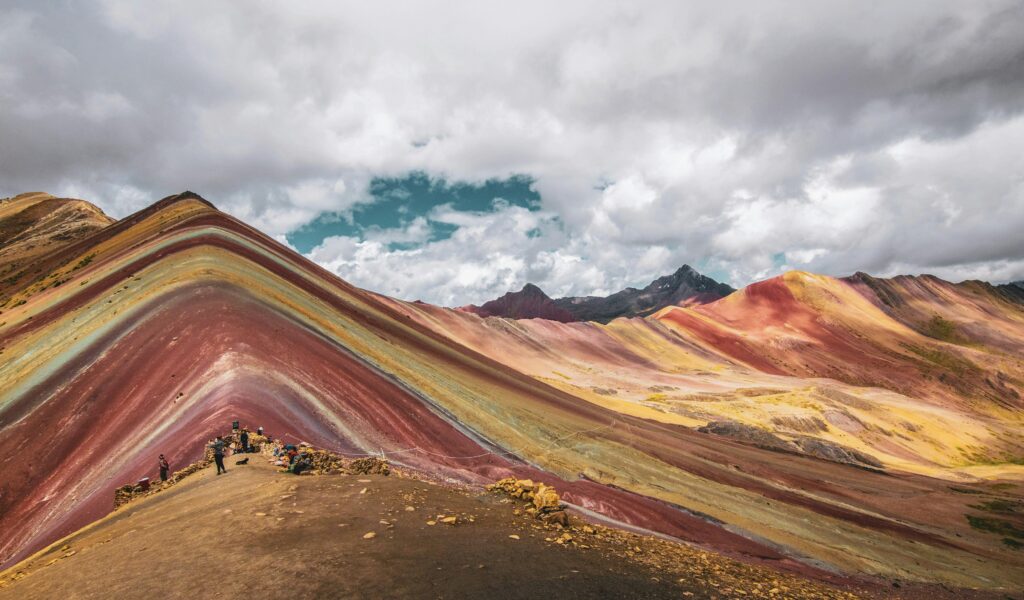
(Problem)
Alright, let’s be honest. You’ve undoubtedly seen that mountain while browsing Instagram. The one with the slopes where it appears someone spilled a huge box of crayons. Rainbow Mountain Peru. Vinicunca. It is definitely striking, regardless of what you choose to call it. I was initially dubious, just like a lot of you. Was the editing just shrewd? Would the hype be matched by the reality? I’ve hiked through Southeast Asian jungles, explored ancient ruins in the Mediterranean, and chased waterfalls in Iceland. A colorful mountain, then? Interesting, yes, but would I be genuinely enthralled?
In all honesty, it was a little intimidating to plan a trip to Rainbow Mountain Peru. I had heard of headaches and dyspnea, so the altitude was a serious worry. It was like negotiating a maze to figure out the logistics of permits, tours, and the ideal time to visit. Furthermore, I wondered if it was really worth it to devote a portion of my Peru itinerary to this one site when I had so many amazing places on my travel list. I recall feeling confused and overpowered as I sat in my apartment and gazed at innumerable blog entries and tour operator websites. Was Rainbow Mountain Peru truly unique, or was it just another overhyped tourist trap?
(Agitation)
My anxiety was only increased by my research. Some blogs described a strenuous hike in which they had to contend with erratic weather and thin air. Others featured seemingly never-ending groups of tourists competing for the ideal shot. I read about the basic amenities, the rocky transportation, and the early start times. To be honest, I questioned whether the Instagrammable views were worth the possible inconvenience and trouble. My suspicions were further stoked when I came across a few reviews from tourists who thought the colors weren’t as vivid in person as they seemed online.
The altitude came next. At an astounding 11,200 feet (3,400 meters), Cusco is the entry point to Rainbow Mountain Peru. The actual mountain is more than 17,000 feet (5,200 meters) high! I’ve had altitude sickness before, so the idea of subjecting my body to such extremes made me think carefully about less taxing alternatives. I began to visualize the nausea, the throbbing headache, and the sensation of my lungs straining to breathe. The image wasn’t appealing.
The logistics appeared to be difficult as well. Should I reserve a tour in advance? Which business is trustworthy? What about entrance fees and permits? Online information was frequently out-of-date or contradictory. I remember one discussion board where hikers argued whether or not it was necessary to rent a horse for a portion of the journey, with some saying it was necessary and others saying it wasn’t. Planning felt like a gamble because of this ambiguity. Rainbow Mountain Peru was something I wanted to see, but I didn’t want it to be a tense or unpleasant experience.
(Solution – Part 1)
Something kept pulling me back to those vivid pictures in spite of my misgivings. The geological marvel that produced those amazing colors had an irresistible charm. I therefore made the decision to jump in. And truthfully? I had an absolutely amazing time at Rainbow Mountain Peru.
The altitude is the unspoken issue that needs to be addressed. It’s high, indeed. incredibly high. The Peruvian Ministry of Health estimates that 15–25% of tourists in areas higher than 8,000 feet (2,400 meters) suffer from some form of altitude sickness. However, most people who are reasonably fit can manage it if they properly acclimate in Cusco for at least two days and take it slow during the trek. I drank a lot of water and coca tea during my three days in Cusco, and I felt surprisingly fine while hiking. Was the air thinner to me? Of course. It wasn’t crippling, though.
Let’s talk about the crowds. It is true that Rainbow Mountain Peru is a well-liked vacation spot. According to recent data from Cusco’s Dirección Regional de Comercio Exterior y Turismo (DIRCETUR), during the busiest time of year (June–August), the site saw an average of 1,500 visitors every day in 2024.
However, you can avoid the biggest crowd and see the mountain with fewer people if you reserve a tour that departs Cusco early (around 3:00 AM). We were among the first groups to arrive thanks to the efforts of my tour operator, a local business named “Andean Treks Peru” (I’ve always had good feedback about them). Although the early start was difficult, the reward of seeing the sunrise add even more vivid hues to the already colorful slopes was something that will never be forgotten.
Although the altitude makes the hike difficult, it is not very technical. The main trail climbs for roughly three miles (5 kilometers) and then descends for the same amount of distance. Depending on your level of fitness and how often you pause to catch your breath (which you will!), a round-trip trek typically takes four to six hours. For about $20 to $30 USD, you can also rent a horse for a section of the climb, which is what many people in our group chose to do. There are some rocky areas mixed in with the majority of dirt paths. Hiking shoes that are comfortable are essential.
What, then, makes Rainbow Mountain Peru so alluring, despite the early reservations and practical difficulties? This geological wonder really lives up to the hype for the following eight reasons:
- The Unbelievable Colors: A Geological Masterpiece
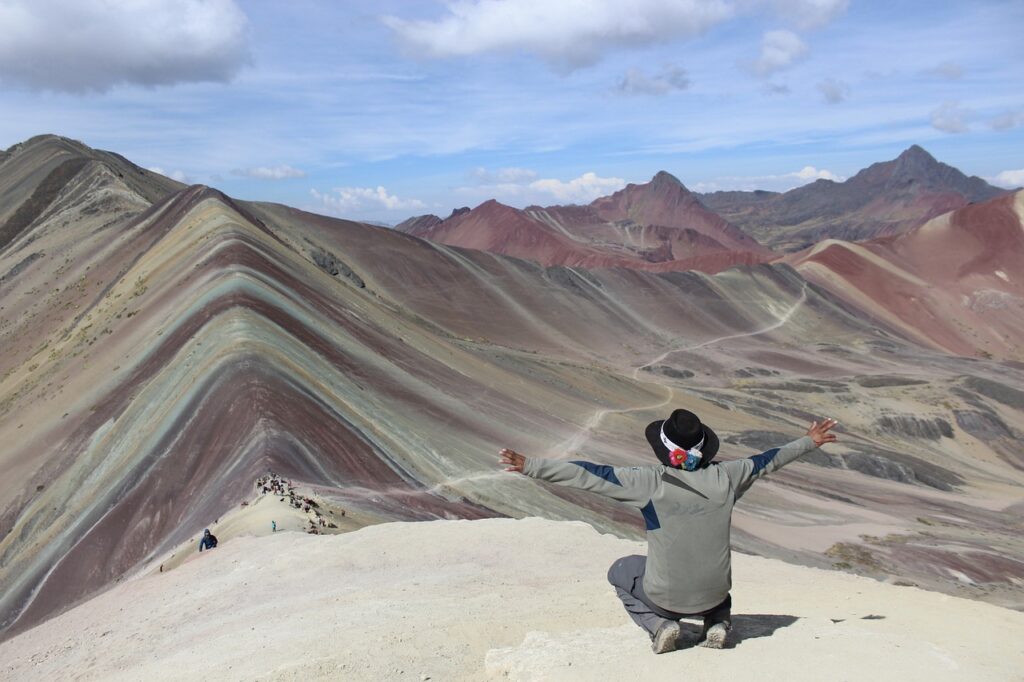
First of all, the colors are authentic. Digital deception is not at play here. The mountain’s striking red, turquoise, yellow, and green stripes are caused by its unique mineral composition, which makes Rainbow Mountain Peru a genuinely remarkable sight. Over millions of years, various sediment layers containing various minerals, including sulfur (yellow), copper sulfate (green/turquoise), and iron oxide (red), were deposited.
The remarkable, multi-hued terrain that exists today is the result of tectonic action forcing these layers upward. According to a study in the Journal of South American Earth Sciences, the primary source of the characteristic coloration is the oxidation of these metallic elements exposed by erosion. The experience of seeing this natural phenomenon is simply not captured in photographs.I remember standing at the viewpoint with the wind blowing past me, completely amazed by the artistry of nature. It resembled standing in front of a massive, painted canvas.
- The Stunning Andean Scenery: A Journey Worth the Destination
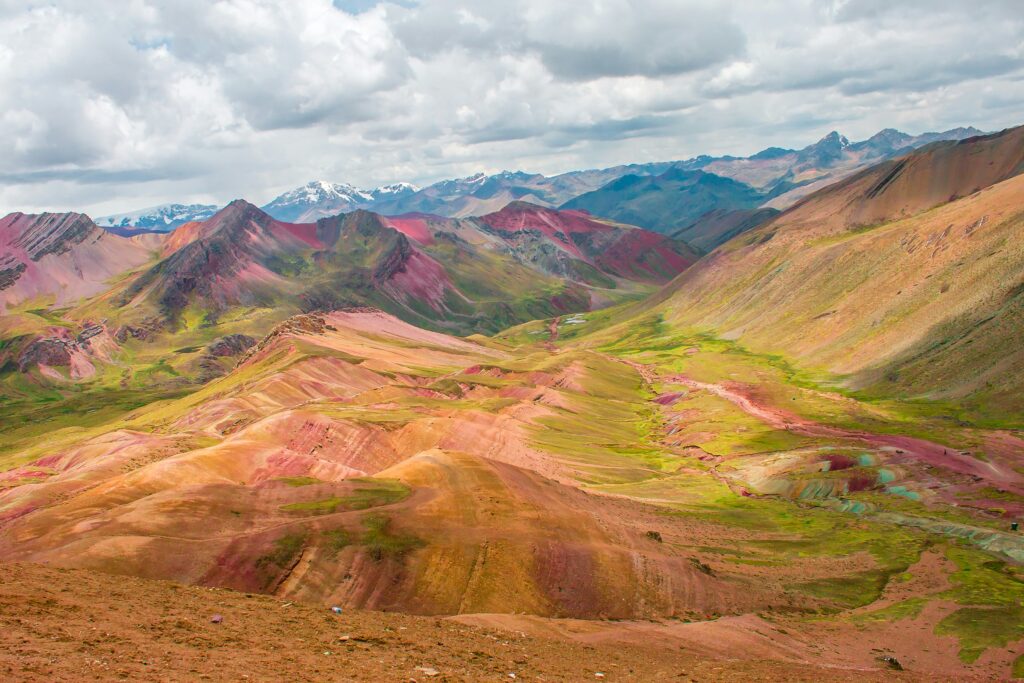
The trip to Rainbow Mountain Peru is a journey unto itself. Beautiful views of snow-capped peaks, undulating green valleys, and traditional Quechua villages can be seen during the drive through the Andean foothills. In the highlands, we saw herds of alpacas and llamas grazing in peace. With its rocky mountains and expansive open areas, the bleak beauty of the terrain serves as a potent reminder of the Andes’ untamed, unadulterated essence. I was in awe of the surroundings’ immense size and grandeur even before we arrived at the main attraction. The goal was to fully immerse ourselves in the Peruvian highlands, not just to see a colorful mountain.
- A Challenging Yet Rewarding Hike: Conquering the Altitude
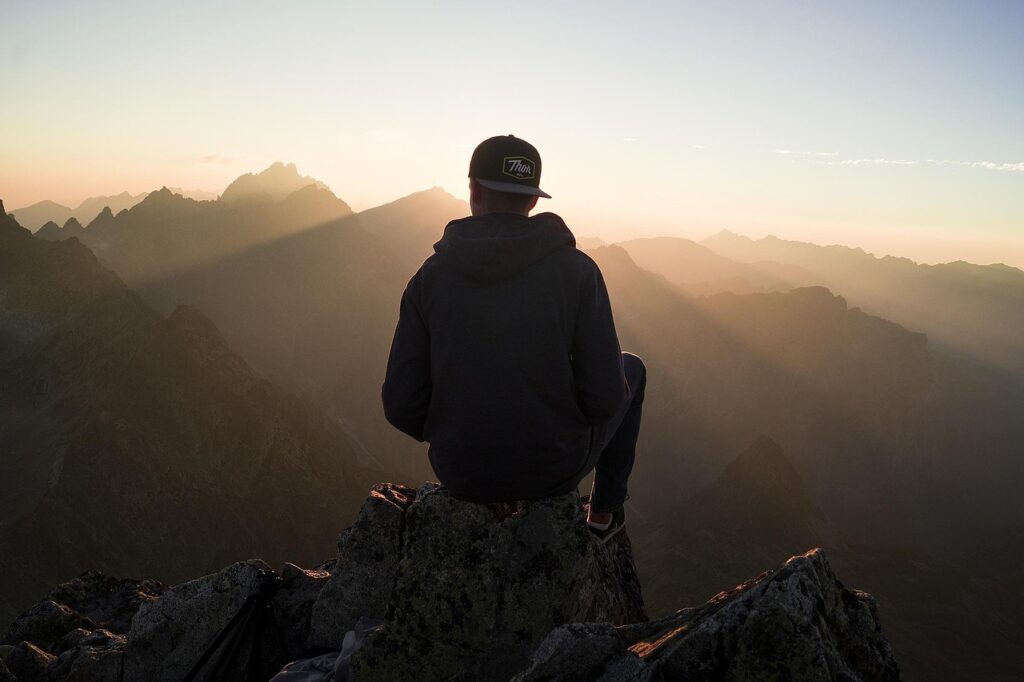
Reaching the summit of Rainbow Mountain Peru provides a tremendous sense of accomplishment, despite the difficulty of the altitude. It is immensely satisfying to push your physical boundaries in such a beautiful setting. It is incredibly thrilling to stand at an elevation of more than 17,000 feet and take in the expansive views of the surrounding mountains.
The average heart rate during the ascent peaked at about 150–160 bpm, based on multiple fitness trackers that my group members used. Undoubtedly, it’s a workout, but the benefits make the effort worthwhile. There was a genuine sense of camaraderie formed when we hiked together and shared that moment of success, all of us a little out of breath but beaming with pride.
- Cultural Immersion: Witnessing Traditional Andean Life
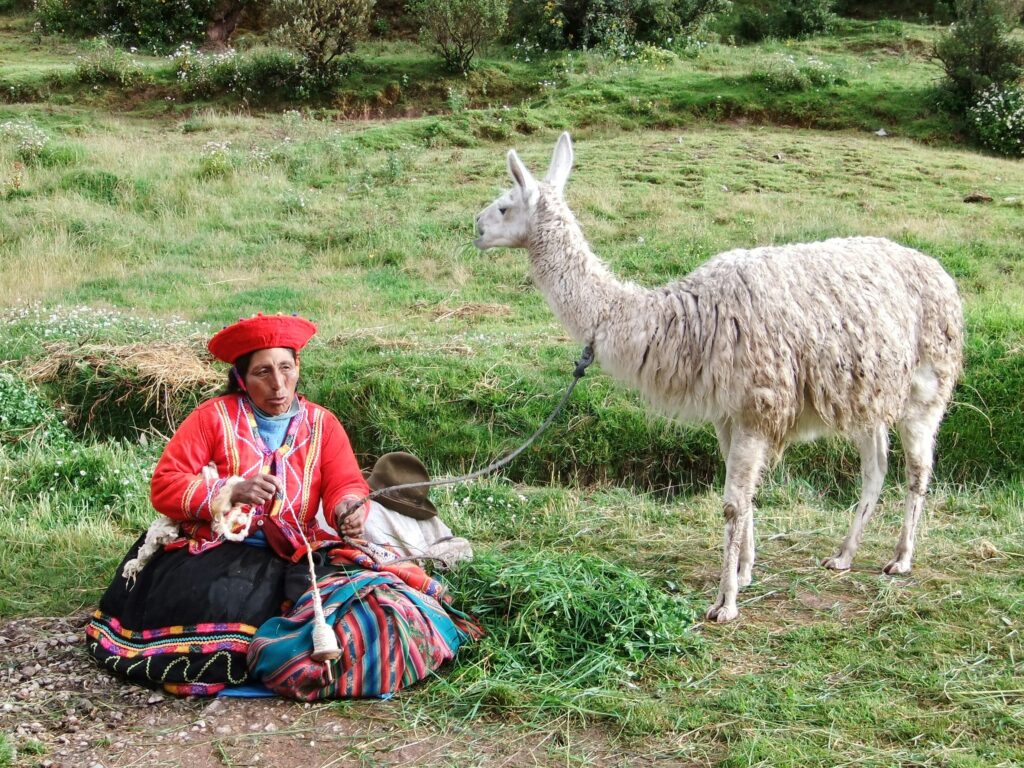
The journey to Rainbow Mountain Peru involves passing through or stopping in little, historic Andean towns. This provides a look into the unique culture and way of life of the local people. We saw women herding animals in colourful traditional dress and children playing in the villages. My trip is one of many that let you interact with local craftspeople peddling their handmade products. This cultural interaction, which reminds us that this incredible natural marvel is part of a rich cultural scene, helps to improve the experience even more. From a nearby woman, I purchased a beautiful hand-woven fabric that acts as a material reminder of the people living in this area.
- The Ever-Changing Light: A Photographer’s Dream
Depending on the sunlight’s angle and intensity, the colors of Rainbow Mountain Peru change throughout the day. While the midday sun intensifies the vibrant hues, early morning light frequently casts a soft glow. Clouds cast striking highlights and shadows as they move across the sky, altering the mountain’s appearance over time. This dynamic interplay of light and color presents countless opportunities for photography enthusiasts, like myself, to take breathtaking pictures. I just watched for hours as the light changed the scenery, providing a new angle and a chance to take pictures.
- A Testament to Natural Processes: Understanding Earth’s History
Rainbow Mountain Peru is more than just a stunning destination; it is a living example of geological activity spanning millions of years. Understanding the processes of sedimentation, tectonic uplift, and mineral oxidation that created this unique landscape adds intellectual interest to the visual spectacle. As she explained the region’s complicated geological past, our guide—a knowledgeable local geologist—pointed out the different mineral layers and explained how they acquired their distinctive colors. This scientific perspective deepened my appreciation of the natural wonder before me.
- The Sheer Scale and Grandeur: Feeling Small in the Face of Nature
You can’t help but be in awe of Rainbow Mountain Peru’s immense size and grandeur when you’re standing at its base. With its soaring peaks and expansive valleys, the Andean landscape is so vast that it makes you feel insignificant in comparison to the might of nature. This humble encounter serves as a potent reminder of the untamed wilderness and unadulterated beauty that still exist in our world. I experienced a deep sense of connection to nature as I gazed out at the seemingly endless mountain range—a feeling that lingers long after you’ve left.
- An Unforgettable Memory: A Story You’ll Want to Share
A trip to Rainbow Mountain Peru is ultimately a once-in-a-lifetime opportunity. It’s an experience that lingers with you long after you’ve left, from the strenuous hike to the stunning vistas and the cross-cultural interactions. A tribute to your spirit of adventure and your admiration for the wonders of our planet, it’s a tale you’ll want to tell your loved ones. I’ve told my story innumerable times, and every time I do it, the rich colors, the clear mountain air, and the sense of achievement are brought back. Rainbow Mountain Peru is more than just a place to visit; it’s a memory that will stay with you forever.
More than just checking off another Instagram-worthy location, my trip to Rainbow Mountain Peru was an adventure. It was a demanding, fulfilling, and ultimately enthralling experience that provided a special fusion of physical activity, cultural immersion, and scenic beauty. Rainbow Mountain Peru ought to be at the top of your list if you’re searching for an experience that will genuinely leave you speechless. Just be sure to pack layers, acclimate, and get ready to be in awe.
Planning Your Rainbow Mountain Peru Adventure: Essential Tips
Are you prepared to organize your own adventure because Rainbow Mountain Peru has captured your attention? Based on my experience and current best practices, the following crucial advice will guarantee a hassle-free and unforgettable trip:
1. Get Used to the Altitude: This is a crucial step. Rainbow Mountain Peru is much higher than Cusco, which is at a high elevation. Before attempting the trek, stay in Cusco for at least two or three days. On your first day, take it easy, stay away from physically demanding activities, and drink lots of water or coca tea, which has long been used to treat altitude sickness. For mild headaches, some travelers also find that over-the-counter pain relievers work well. Don’t push yourself too hard at first; instead, pay attention to your body
2. Pick a Reputable Tour Operator: There are many tour operators that offer trips to Rainbow Mountain Peru. Seek out businesses that have seasoned tour guides, positive reviews, and a dedication to responsible travel and safety. Find out if they have oxygen available in an emergency and how qualified their guides are to handle altitude sickness. To guarantee your spot, I advise making reservations in advance, particularly during the busiest months (June to August). Depending on the inclusions (meals, transportation, guide), a full-day tour from Cusco usually costs between $50 and $100 USD.
3. Wear layers because the Andean climate is erratic and subject to sudden changes. Because of the high altitude, it can get cold even on sunny days, particularly in the morning and at the top. Put on layers of easily removable clothing, such as a fleece jacket, a thermal base layer, a waterproof and windproof outer layer, gloves, a hat, and sunglasses. Hiking pants that are comfortable are also advised.
4. Wear Appropriate Footwear: The Rainbow Mountain Peru trek entails walking on rocky and uneven terrain. Hiking boots that are comfortable, sturdy, and provide adequate ankle support are crucial. To prevent blisters, make sure they are well broken in before your trip.
5. Pack Essentials: The following is a list of things you absolutely need to bring on your trip to Rainbow Mountain Peru: * Water (at least two liters per person) * Snacks (nuts, dried fruit, energy bars) * High SPF sunscreen * SPF lip balm Sunglasses, a small backpack to hold your necessities, a camera to record the breathtaking views, cash in local currency (soles) for souvenirs or the optional horse rental, any personal medications, and a small first-aid kit
6. Pace Yourself: The elevation makes the hike difficult. Go slowly, take regular breaks, and pay attention to your body. If you’re having trouble breathing, don’t try to keep up with other people. Our guide stressed the value of moving at a steady pace and taking baby steps.
7. Take into Account Hiring a Horse (Optional): If the uphill hike is especially difficult for you, you may want to consider hiring a horse for part of the climb. It can be scheduled on the spot and usually costs between $20 and $30 USD. You will still need to hike the remaining distance to the viewpoint, though, as the horse will only take you halfway.
8. Honor the Local Environment and Culture: Pay attention to the local populations and their traditions. Avoid littering, dress appropriately, and get someone’s permission before taking their picture. Select tour companies that promote eco-friendly travel strategies and help the community’s economy.
9.Be Ready for Early Starts: In order to accommodate the drive and arrive at Rainbow Mountain Peru ahead of the busiest visitors, the majority of tours begin at a very early hour (approximately 3:00 AM). A long day is ahead of you.
10. Examine the Weather Forecast: Prior to your hike, review the weather forecast and be ready for any changes. Even if the forecast appears clear, it is always a good idea to have rain gear.
11. Travel Insurance: Make sure you have sufficient travel insurance that covers high-altitude activities and medical emergencies.
12. Remain Hydrated: Both during the actual hike and in the days preceding it, make sure to consume an adequate amount of water. This avoids dehydration and aids in acclimatization
You can have the most fun and stay safe on your trip to Rainbow Mountain Peru by heeding these recommendations. It’s a really amazing place, and if you plan ahead, you’ll have an absolutely amazing time.
http://ecotrip360.com/disclaimer
Follow me on Facebook: https://www.facebook.com/profile.php?id=61574792461434



